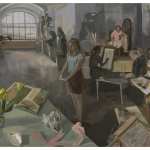�At Home and Abroad: The Transcendental Landscapes of Christopher Pearse Cranch,� curated by Nancy Stula. Lyman Allyn Art Museum, New London, CT. Through Feb. 24. Travels to the Newington-Cropsey Foundation, Hastings-on-Hudson, New York, NY, March 17 through May 31, 2008.
Despite a fifty-year career as a landscape painter, Christopher Cranch�s paintings are little known. Instead, he is best known for his poetry and his ties to the New England Transcendentalists. Like Thoreau writing of the daily trials of life on Walden Pond, Cranch attempted, in his landscapes, to express the correspondence between nature and deeper spiritual concepts. At the Lyman Allyn, a small regional museum in New London, CT, housed in a charming Neo-Classical building designed by Charles A. Platt, curator Nancy Stula has organized a comprehensive show of Cranch’s work. In the NYTimes, Benjamin Genocchio reports that Cranch’s paintings, although grounded in transcendental theory, are hard to differentiate from those of his peers. “American Transcendentalism was a spiritual philosophy that emerged in New England in the early 19th century. Ralph Waldo Emerson and Henry David Thoreau were among its disciples. At its core was a belief in the possibility of direct access to the divine through nature, without any kind of mediation from the church, prophets or the Bible. Nature itself, it was believed, was a kind of perfect spiritual state. As a landscape painter, Cranch ventured out into nature in search of the miraculous, something that would touch his soul. He began painting romantic mountain vistas with lonely frontiersmen in the manner of the great Hudson River School painters Thomas Cole, Asher B. Durand and Frederic Edwin Church, with whom he often exhibited his paintings in major group shows. Durand, in particular, was an early mentor and guide. Ms. Stula argues in the exhibition catalog that ‘what distinguishes Mr. Cranch�s landscapes from those of other American landscape painters is that his paintings can be seen as a visualization of transcendental philosophy.’ I am not sure about this statement, for given that Cranch�s paintings are often so similar to those of his peers, it can be hard to tell one from the other. What properly distinguishes Cranch, it seems to me, was the explicit desire to have his nature paintings seen as a visualization of the divine.” Read more.













